
Odontogenic sinusitis is a pathological process that consists in inflammation of the maxillary sinus. Transmitted from a sick tooth molar. Associated with the ailment is that the roots of the teeth are concentrated nearby or even inside the sinus. This opens up all the ways to penetrate the infection to the mucous membrane of the sinus. For small patients who do not yet have molars, this form of the disease is not inherent.
Content
- 1 Symptoms
- 1.1 difference from rhinogenous
- 2 Forms
- 2.1 Acute
- 2.2 Chronic
- 3 Pharmacotherapy
- 4 Folk treatment
- 4.1 Drops
- 4.2 Tampons
- 4.3 Inhalation
- 5 Operational path
Symptoms
Recognize odontogenic sinusitis can be the followingfeatured:
- pain under the nasal eye and focused on one side of the face;
- nasal congestion;
- release a large amount of pus having a bad smell;
- pain in the teeth, which are concentrated in the upper jaw.
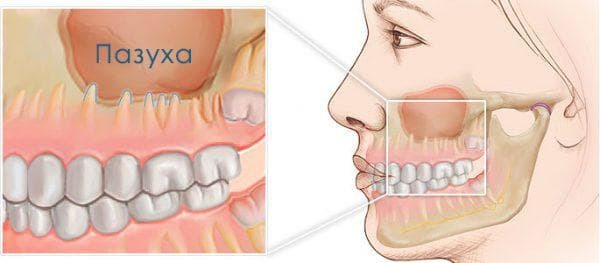
In the picture - odontogenic sinusitis
Odontogenic sinusitis always makes itself felt by strong pains in the teeth. Sometimes pain occurs after removal or treatment of one of the teeth. The patient feels a strong headache, heaviness in the head. At the same time, the clinical picture only intensifies when it is tilted.
If the timely treatment does not take the acute form of the pathological process, then it will pass into the chronic. Symptoms will be similar, but only to visit the patient they will already be on an ongoing basis. Painful sensations will occur in periods, and the nose is permanently embedded. From the nasal cavity there is a small amount of white mucus, which has a bad smell.
Sometimes, the inflammatory process that occurs in the sinuses can affect the nasal cavity. This is fraught with the formation of polyps, for the elimination of which you will have to use radical methods of treatment. Sometimes there is a nonspecific clinical picture, when the paranasal sinuses are concentrated near the brain. As a result, a person feels weakness, fatigue, lethargy and reduced efficiency.
On video odontogenic sinusitis:
Difference from rhinogenic
Rhinogenic sinusitis and odontogenic differ from each other. And these differences affect not only the symptoms, but also the reasons for which the pathological process has developed. For the odontogenic form of sinusitis, pain is concentrated on one side. But with rhinogenic sinusitis, pain can be traced from two sides. 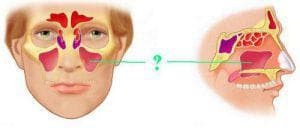
The development of rhinogenic inflammation is affected by chronic rhinitis, influenza, scarlet fever, measles, viral and infectious ailments. But the development of odontogenic sinusitis occurs against the background of dental problems. Call the inflammatory process can teeth, in which the root system is more developed in the maxillary sinuses.
Forms of
Sinusitis, which has arisen against the background of dental pathologies, most often involves only one sinus in the inflammation. If you stay at home with unbearable pain for a long time and do not seek qualified help, the sinusitis will affect the other sinus, as a result of which it will become bilateral. According to the duration of the period of illness, acute, subacute and chronic sinusitis are distinguished. In addition, its course can be acute and chronic.
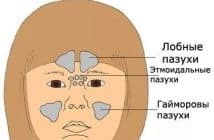 What kind of drops in the nose with sinusitis and sinusitis should be used first, will help to understand this article.
What kind of drops in the nose with sinusitis and sinusitis should be used first, will help to understand this article.
And here's how to use Sumamed with sinusitis, and as far as this tool is effective, it will help to understand this information.
It will also be interesting to know which antibiotics for sinusitis should be used first: http: //prolor.ru/n/ lechenie-n / antibiotiki-pri-sinusite.html
You may also be interested in learning how to treat sinusitis in children.
Acute
In the acute course of a pathological process, the patient has the following symptoms:
- Pain and a feeling of swelling in the gums, which only increase with eating.
- Discharge from the nasal cavity, with the side that is affected. In the beginning, it's just mucus, but then comes pus green or white.
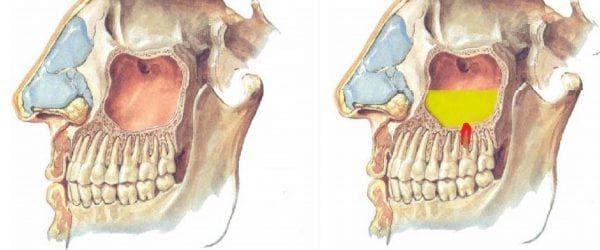
Acute odontogenic sinusitis
- Pain in the head, weakness, pain in the eyes in bright light.
- The climb temperature is up to 39 degrees.
- Chest edema.
- Bad breath.
- Sleep disturbance.
Chronic
If acute sinusitis has not been cured in time, then it will peretknet in chronic. It is characterized by persistent symptoms that are very similar to the clinical picture of an acute current pathological process, but they are less intense.

Chronic odontogenic sinusitis
For chronic inflammation, the following symptoms are characteristic:
- painful sensations in the affected gum;
- mucus purulent in nature and nasal congestion, which leads to a violation of the sense of smell;
- weakness, fatigue and decreased performance;
- headaches and discomfort in the nose bridge.
The chronic form of the pathological process can occur without obvious symptoms. But after a long stay in the cold or with diseases of acute respiratory viral infection, exacerbation occurs, resulting in acute sinusitis.
Medical treatment
Therapy of odontogenic sinusitis reduces to the use of vasoconstricting drops and antibacterial drugs:
- Nasal drops - Galazolindlja for children, Nafazoli or Xylometazoline. They effectively cope with nasal congestion, stop the swelling of the mucosa and quickly evacuate the mucous discharge.

Antibiotics of the penicillin group - Ampicillin, Amoxicillin( and what is the dosage of Amoxicillin for sinusitis is necessary, and how to determine it, is described in this article)
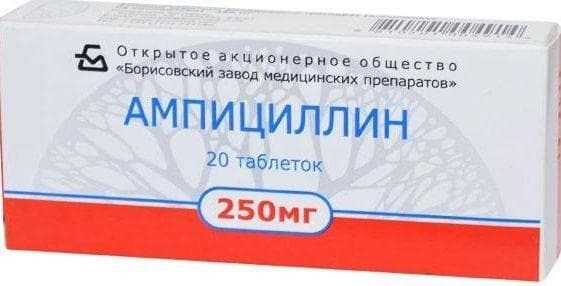
Ampicillin in tablets
- Cephalosporins - Cefazolin, Cefalexin.

Cephalosporins for injection
- Macrolides - Azithromycin( and here are some reviews about Azithromycin that is used in angina, there are, you can read in this article) Erythromycin.
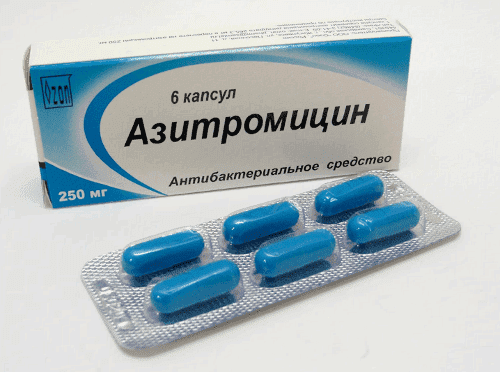
Azithromycin in capsules
- Antibacterial drugs of local action - spray Bioparox.
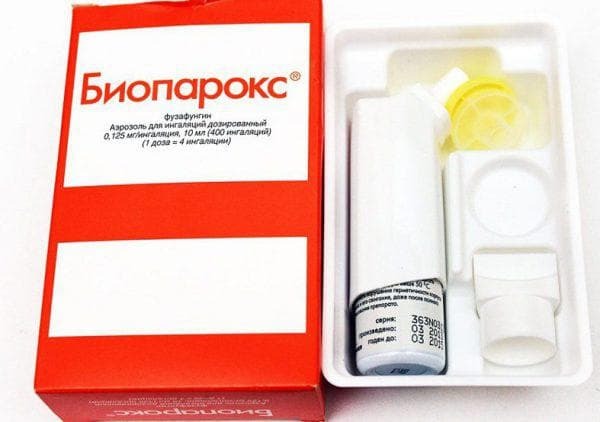
Bioparox
These are the main medicines that are used in the treatment of odontogenic sinusitis. If everything is observed correctly, acute forms of the pathological process will recede after 5-7 days.
In addition, to activate the processes and quickly achieve a positive result, it is necessary to perform procedures for washing the nasal cavity. These manipulations are used in the treatment of various forms of sinusitis or sinusitis. For these purposes, you can buy solutions such as Furacilin, AquaMaris( and how to rinse the nose with an infant with Aquamaris will help understand this article) or infusions of antiseptic herbs - Plantain, Camomile and St. John's Wort.
Traditional treatment
In folk medicine, many effective recipes are stored, which can be used to treat odontogenic sinusitis.
Drops
It is this form of medicine that is actively used in the treatment of pathology, since it is possible to prevent absorption of the solution and general influence on the body. If after using the homemade drops you have burning or other unpleasant symptoms, then the medicine should be diluted with milk and water, taken in equal proportion. The most effective are the following recipes:
- Take aloe and calanchoe, cut off the leaves and put it in the refrigerator for 7 days. Then grind them, and squeeze out the juice from the resulting gruel. Install it in the refrigerator for 2 days. Drip 2 drops in each nasal passage 3 times a day.

Drops of aloe in the nose
- You can drip your nose with oil drops, derived from garlic and sea-buckthorn. To do this, crush 3 cloves of garlic, add 50 ml of sea-buckthorn oil and wait for 20 hours. Then filter and drip 3-4 drops in each nasal passage 3 times a day.
- Take the juice of onion and cabbage, add to them 20 ml of vegetable oil. Drip on a full pipette 3 times a day. After this, you must lie down.
- Fresh black radish juice is instilled in the amount of a full pipette. Get a positive result with long-term treatment.
Tampons
In the treatment of odontogenic sinusitis, nasal swabs treated with a curative composition can be used. They need to be done before bedtime, and the duration of their influence will be 20-30 minutes. Effective are such solutions:
- Decoction of laurel leaves. Take a few leaves, grind and boil for 10 minutes.
- Decoction of chamomile, calendula, sage.

Broth from laurel leaves
- Take the juice of the onion, 4 aloe leaves, 100 g of cyclamen root and 10 ml of birch juice. The course of therapy is 20 days.
Inhalations
Several therapeutic options can be used to perform therapeutic inhalations for sinusitis:
- boiled potatoes;

Inhalation of potatoes
- mint broth in combination with tea tree ether;
- leaf broth or eucalyptus ether;
- boiling water in combination with juniper oil, fir.
The presented agents have a bactericidal effect, and also effectively cope with bacteria.
Operative pathway
If monotogenic sinusitis occurs with complications, the physician decides to perform the operation. To date, there are two methods of surgical intervention:
- Radical .Its essence is that the doctor performs a cut under the upper lip. Today, this method of therapy is rarely used, since it is traumatic and has a mass of complications.
- Endoscopic .When using it, a specialist inserts a tool into the nasal passage or the socket of the tooth. When this traumatization of healthy tissue is negligible, and the procedure itself is easier to transfer, because the risk of complications is absent.
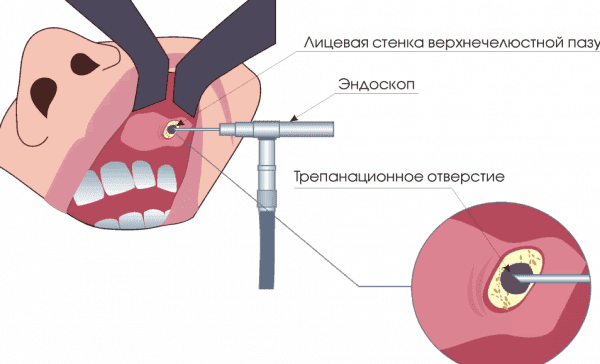
Endoscopy of odontogenic sinusitis
Odontogenic sinusitis is a common disease that is accompanied by severe pain and nasal congestion. There is a pathological process in two forms - acute and chronic. The treatment is complex, including preparations of local and complex influence. In severe inflammation, surgery is prescribed.
- Cephalosporins - Cefazolin, Cefalexin.
